Realization of Hollow-Core Photonic-Crystal Fiber Optic Gyro Based on Low-Noise Multi-Frequency Lasers with Intermediate-Frequency Difference
Abstract
1. Introduction
2. Methods
2.1. Overall Structure
2.2. Homologous Heterodyne Digital Optical Phase-Locked Loop
3. Results and Discussion
4. Conclusions
Author Contributions
Funding
Acknowledgments
Conflicts of Interest
References
- Sanders, G.A.; Strandjord, L.K.; Qiu, T. Hollow core fiber optic ring resonator for rotation sensing. In Proceedings of the Optical Fiber Sensors, Cancun, Mexico, 23–27 October 2006. [Google Scholar]
- Terrel, M.A.; Digonnet, M.J.F.; Fan, S. Resonator fiber optic gyroscope using an air-core fiber. J. Lightwave Technol. 2012, 30, 931–937. [Google Scholar] [CrossRef]
- Sanders, G.A.; Sandersa, S.J.; Strandjordb, L.K.; Qiu, T.; Wu, J.; Smiciklas, M.; Mead, D.; Mosor, S.; Arrizon, A.; Ho, W.; et al. Fiber optic gyro development at Honeywell. In Proceedings of the SPIE Commercial + Scientific Sensing & Imaging, Baltimore, MD, USA, 17–21 April 2016; 985207. [Google Scholar]
- Ayotte, S.; Faucher, D.; Babin, A.; Costin, F.; Latrasse, C.; Poulin, M.; Deschênes, É.G.; Pelletier, F.; Laliberté, M. Silicon photonics-based laser system for high performance fiber sensing. In Proceedings of the 24th International Conference on Optical Fibre Sensors, Curitiba, Brazil, 28 September–2 October 2015; p. 963413. [Google Scholar]
- Jiao, H.; Feng, L.; Zhang, C.; Liu, N.; Zhang, Y.; Ma, H. Design of low-crosstalk polarizing resonator and homologous multi-frequency differential detection for hollow-core photonic-crystal fiber optic gyro. Opt. Express 2019, 27, 19536–19547. [Google Scholar] [CrossRef] [PubMed]
- Strandjord, L.K.; Qiu, T.; Salit, M.; Narayanan, C.; Smiciklas, M.; Wu, J.; Sanders, G.A. Improved bias performance in resonator fiber optic gyros using a novel modulation method for error suppression. In Proceedings of the 26th International Conference on Optical Fiber Sensors, Lausanne, Switzerland, 24–28 September 2018. [Google Scholar]
- Zhang, C.; Feng, L.; Jiao, H.; Liu, N.; Zhang, Y.; Wang, X. Free spectral range measurement using homologous heterodyne optical phase-locked loop based on acousto-optic modulation. Appl. Opt. 2019, 58, 5817–5822. [Google Scholar] [CrossRef] [PubMed]
- Zhang, Y.; Feng, L.; Li, H.; Jiao, H.; Liu, N.; Zhang, C. Resonant fiber optic gyroscope with three-frequency differential detection by sideband locking. Opt. Express 2020, 28, 8423–8435. [Google Scholar] [CrossRef] [PubMed]
- Feng, L.; Ren, X.; Deng, X.; Liu, H. Analysis of a hollow core photonic bandgap fiber ring resonator based on micro-optical structure. Opt. Express 2012, 20, 18202–18208. [Google Scholar] [CrossRef] [PubMed]
- Jiao, H.; Feng, L.; Wang, J.; Wang, K.; Yang, Z. Transmissive single-beam-splitter resonator optic gyro based on a hollow-core photonic-crystal fiber. Opt. Lett. 2017, 42, 3016–3019. [Google Scholar] [CrossRef] [PubMed]
- Yan, Y.; Ma, H.; Wang, L.; Li, H.; Jin, Z. Effect of Fresnel reflections in a hybrid air-core photonic-bandgap fiber ring-resonator gyro. Opt. Express 2015, 23, 31384–31392. [Google Scholar] [CrossRef] [PubMed]
- Yu, J.; Jia, Z.; Xu, L.; Chen, L.; Wang, T.; Chang, G. DWDM optical millimeter-wave generation for radio-over-fiber using an optical phase modulator and an optical interleaver. IEEE Photonics Technol. Lett. 2006, 18, 1418–1420. [Google Scholar]
- Wang, W.; Liu, J.; Mei, H.; Zhu, N. Phase-coherent orthogonally polarized optical single sideband modulation with arbitrarily tunable optical carrier-to-sideband ratio. Opt. Express 2016, 24, 388–399. [Google Scholar] [CrossRef] [PubMed]
- Wang, X.; Feng, L.; Zhou, Z.; Li, H.; Liu, D.; Wang, Q.; Liu, L.; Jia, Y.; Jiao, H.; Liu, N. Real-time free spectral range measurement based on optical single-sideband technique. Opt. Express 2018, 26, 7494–7506. [Google Scholar] [CrossRef] [PubMed]
- Waen, Y.J.; Liu, H.F.; Novak, D.; Ogawa, Y. Millimeter-wave signal generation from a monolithic semiconductor laser via subharmonic optical injection. IEEE Photonics Technol. Lett. 2000, 12, 1058–1060. [Google Scholar]
- Langley, L.N.; Elkin, M.D.; Edge, C.; Wale, M.J.; Gliese, U.; Huang, X.; Seeds, A.J. Packaged semiconductor laser optical phase-locked loop (OPLL) for photonic generation, processing and transmission of microwave signals. IEEE Trans. Microwave Theory Tech. 1999, 47, 1257–1264. [Google Scholar] [CrossRef]
- Bordonalli, A.C.; Walton, C.; Seeds, A.J. High-performance phase locking of wide linewidth semiconductor lasers by combined use of optical injection locking and optical phase-lock loop. J. Lightwave Technol. 1999, 17, 328–342. [Google Scholar] [CrossRef]
- Zheng, J.C.; Jin, T.; Chi, H.; Tong, G.C.; Zhu, X.; Lai, T.H. Comparison and optimization of phase locked loop and injection locking techniques for optoelectronic oscillators. Acta Photonica Sin. 2017, 46, 68–73. [Google Scholar]
- Ramos, R.T.; Seeds, A.J. Delay, linewidth and bandwidth limitations in optical phase-locked loop design. Electron. Lett. 1990, 26, 389–391. [Google Scholar] [CrossRef]
- Gardner, F.M. Phaselock Techniques, 3rd ed.; People Post Press: Beijing, China, 2007; pp. 6–23. [Google Scholar]
- Jin, Z.; Yu, X.; Ma, H. Resonator fiber optic gyro employing a semiconductor laser. Appl. Opt. 2012, 51, 2856–2864. [Google Scholar] [CrossRef] [PubMed]
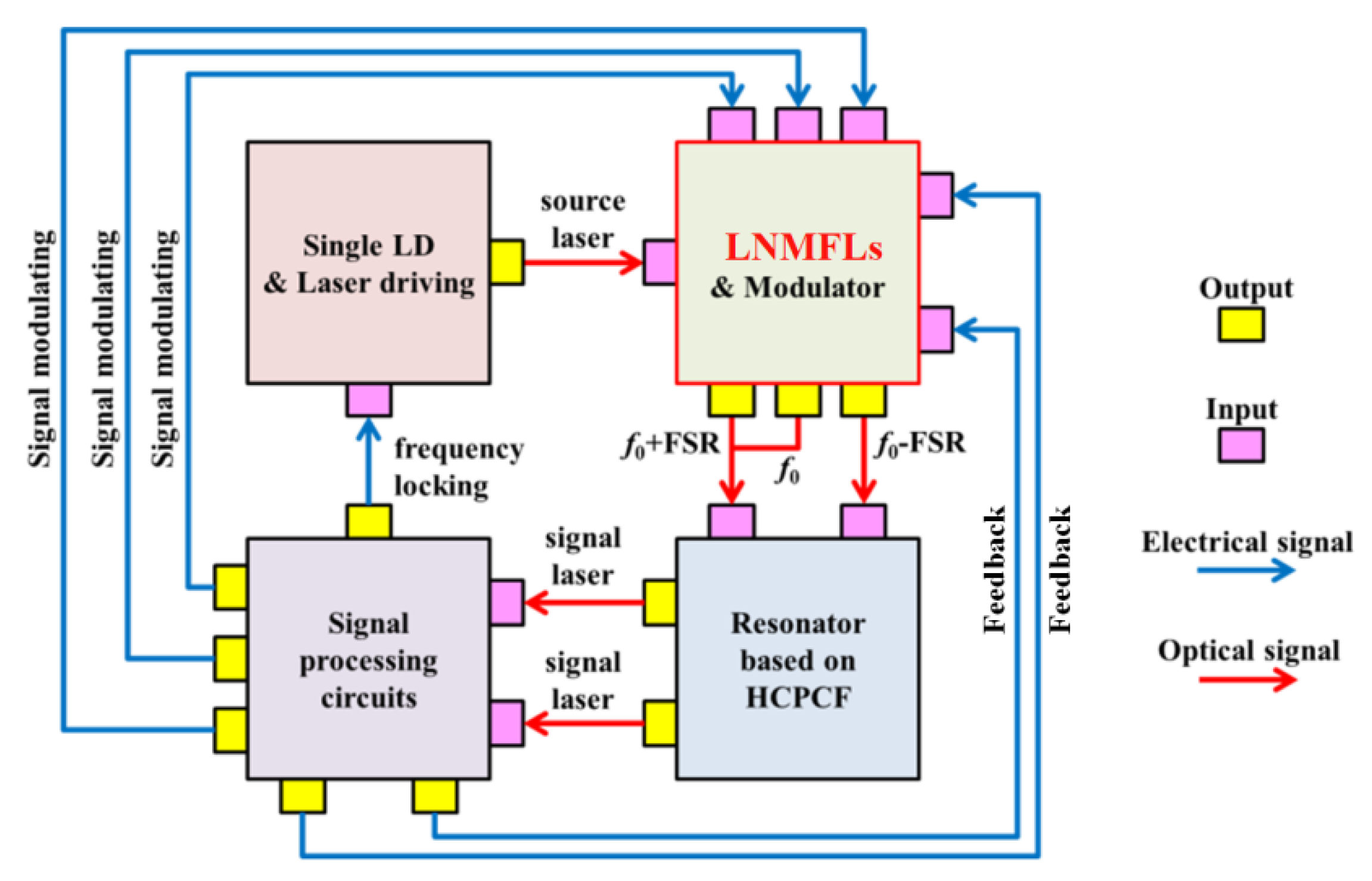
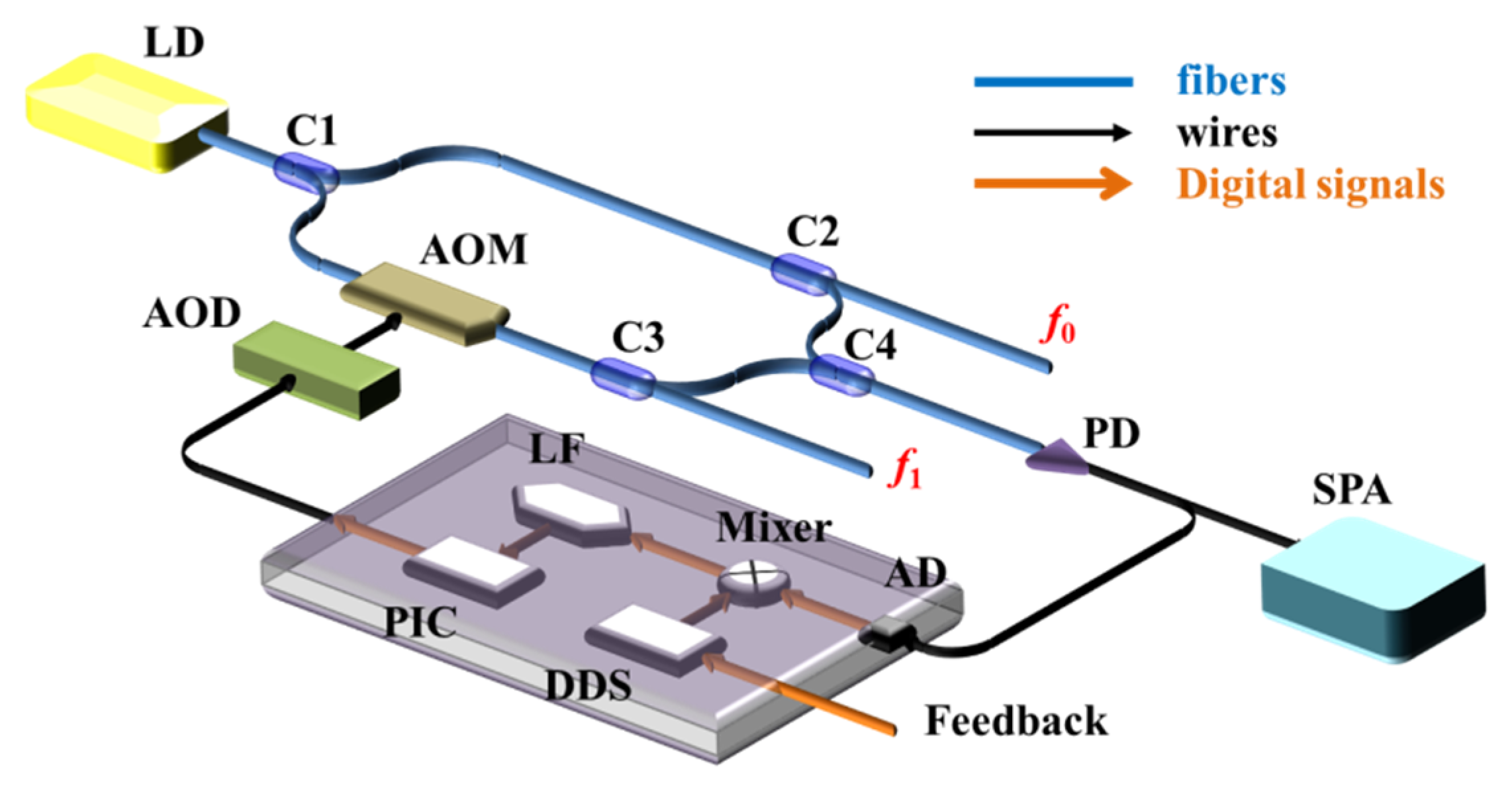
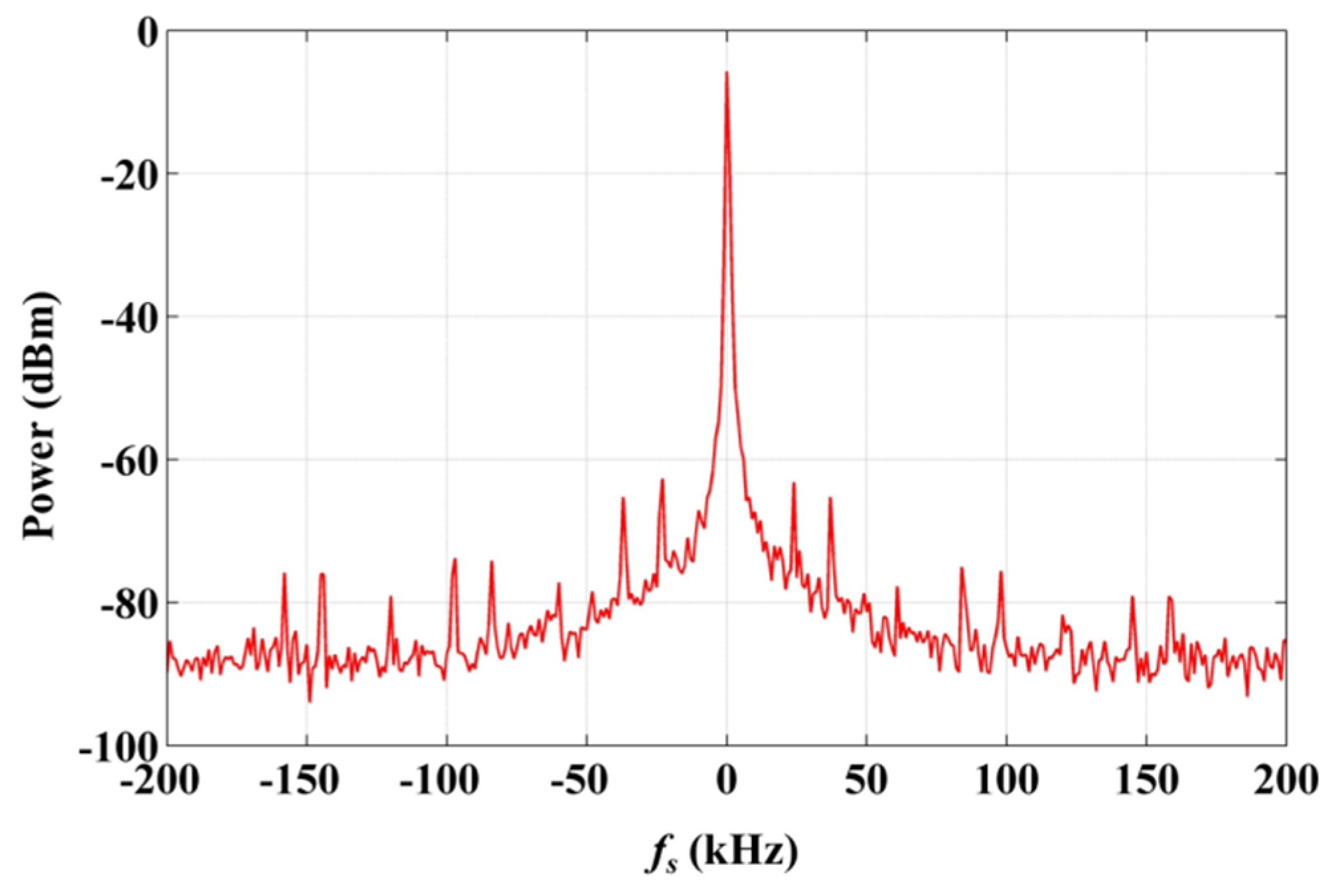
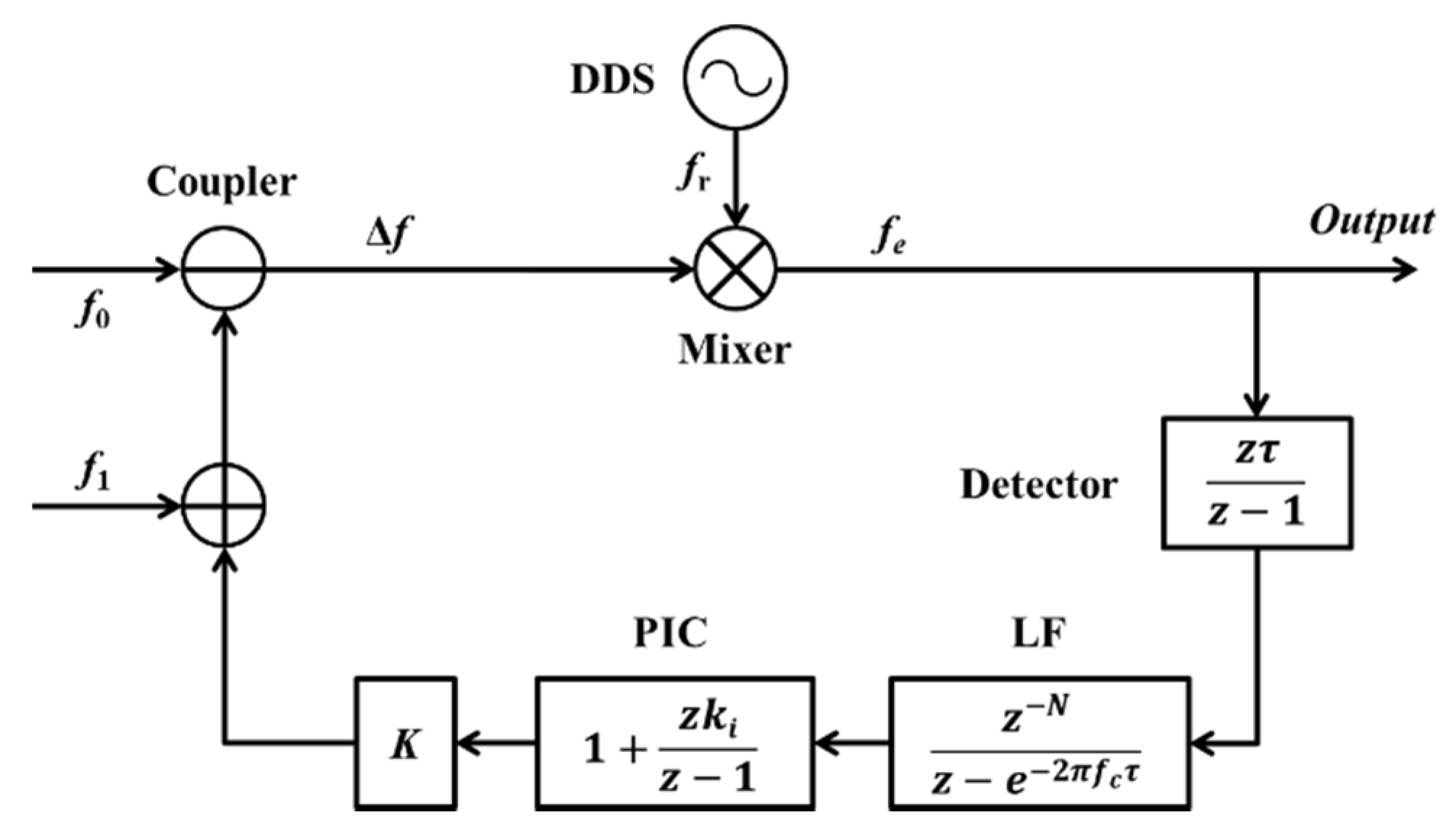
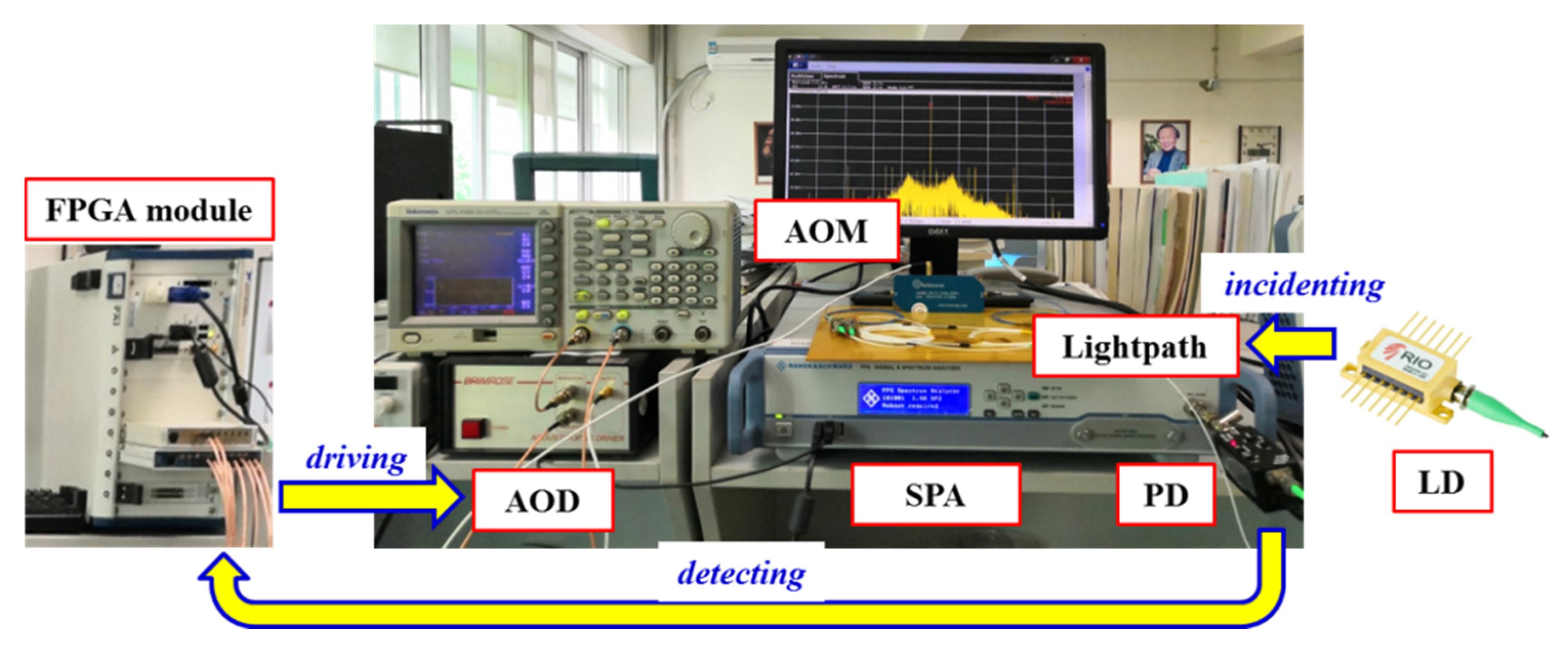
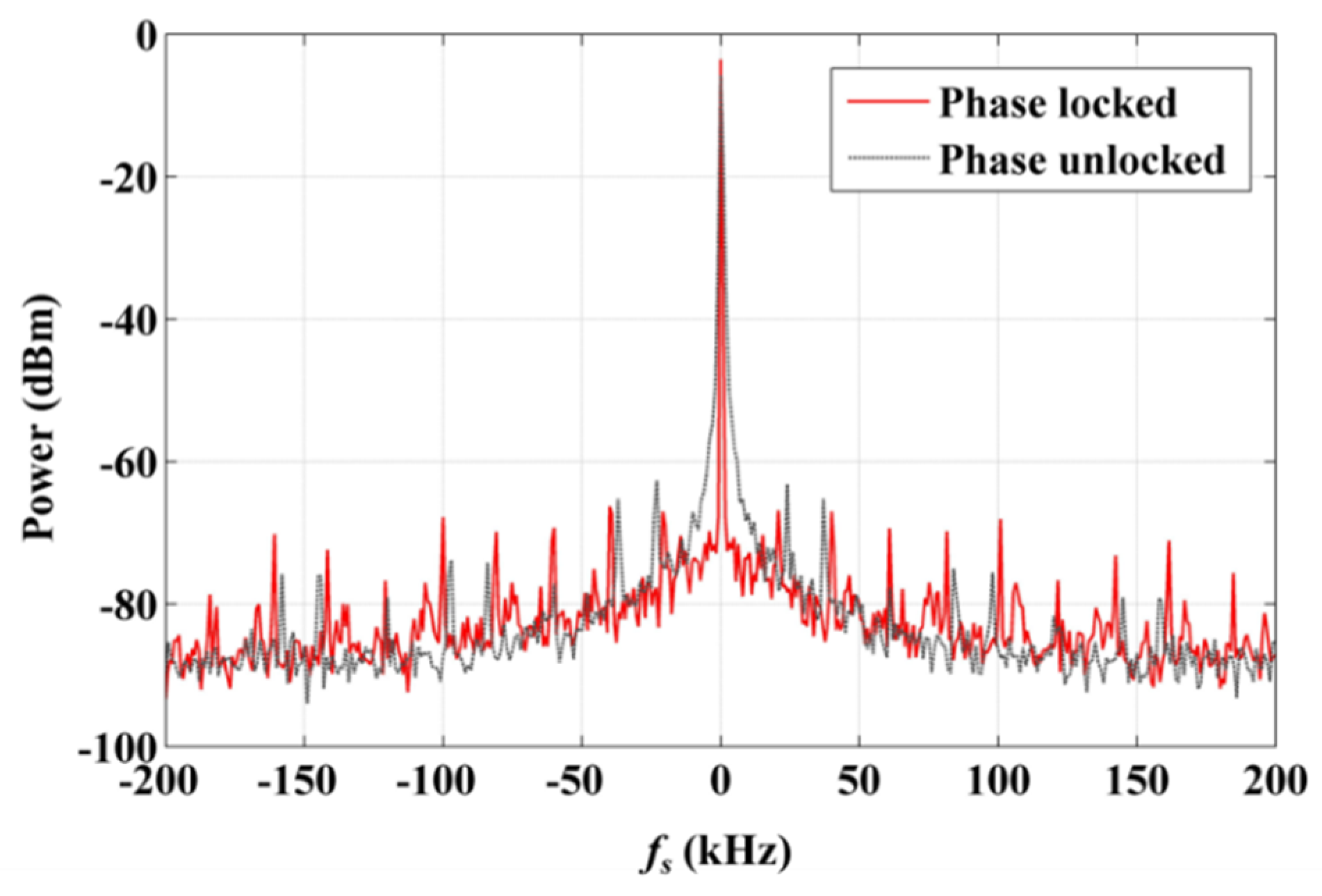
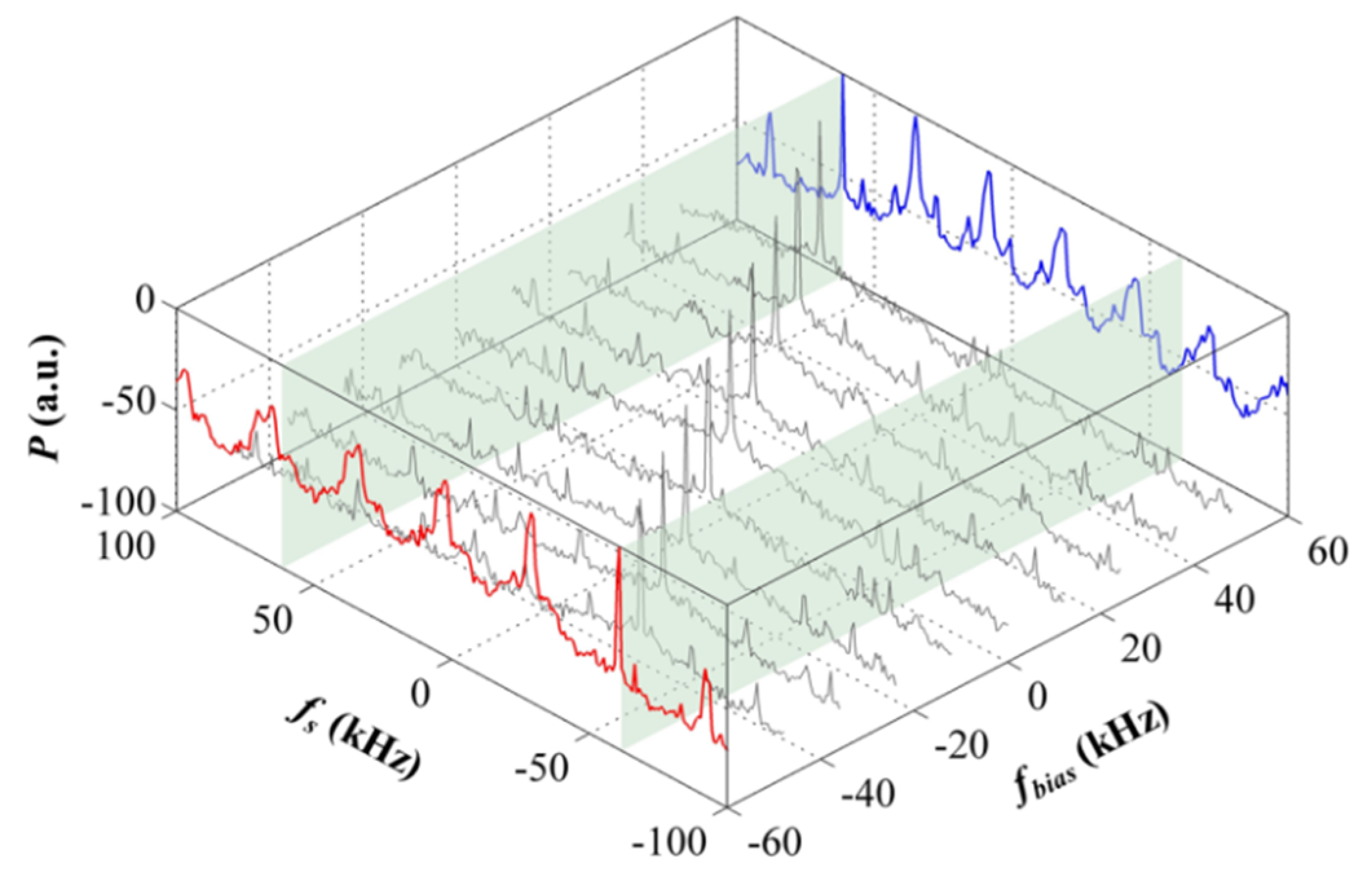
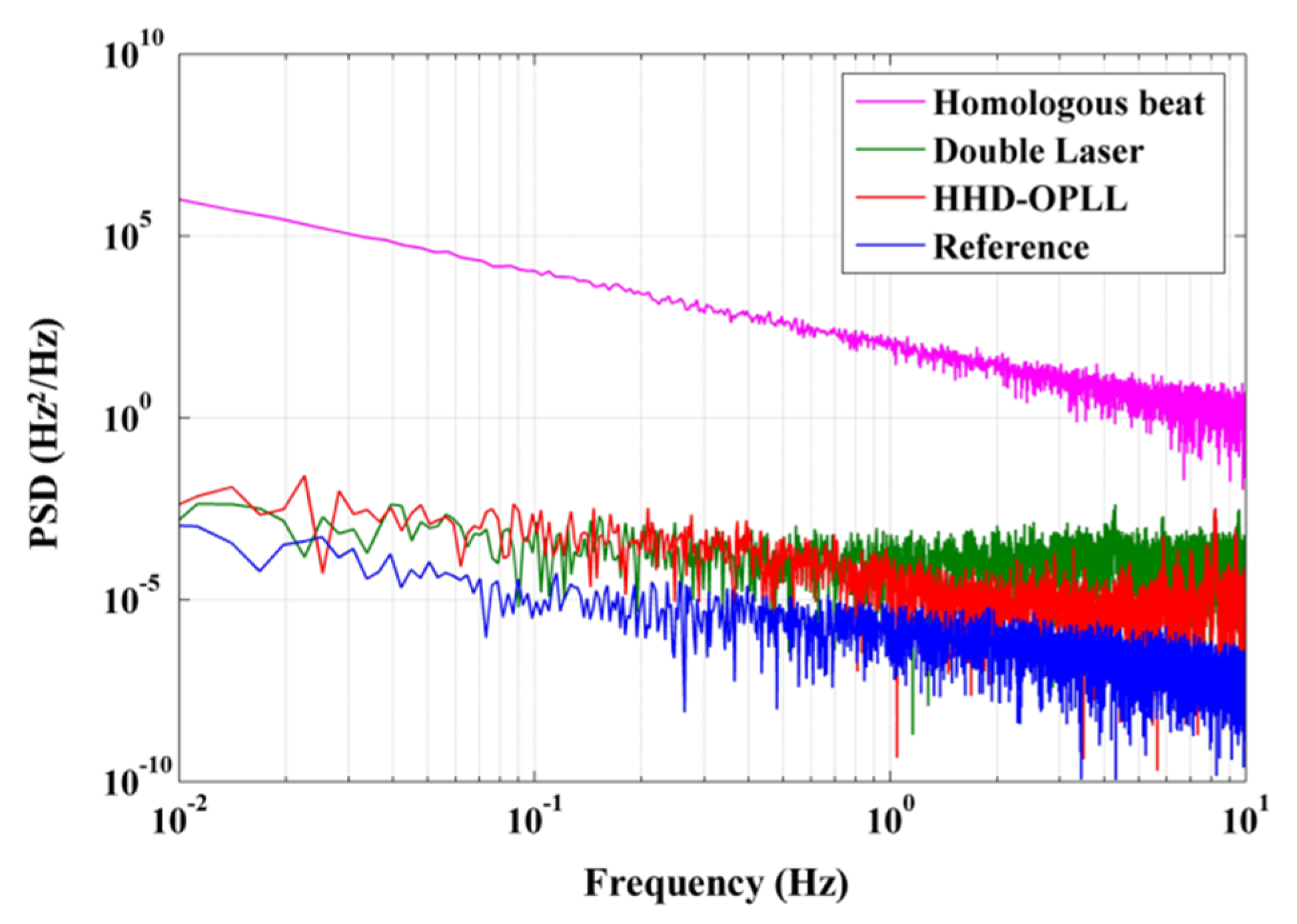
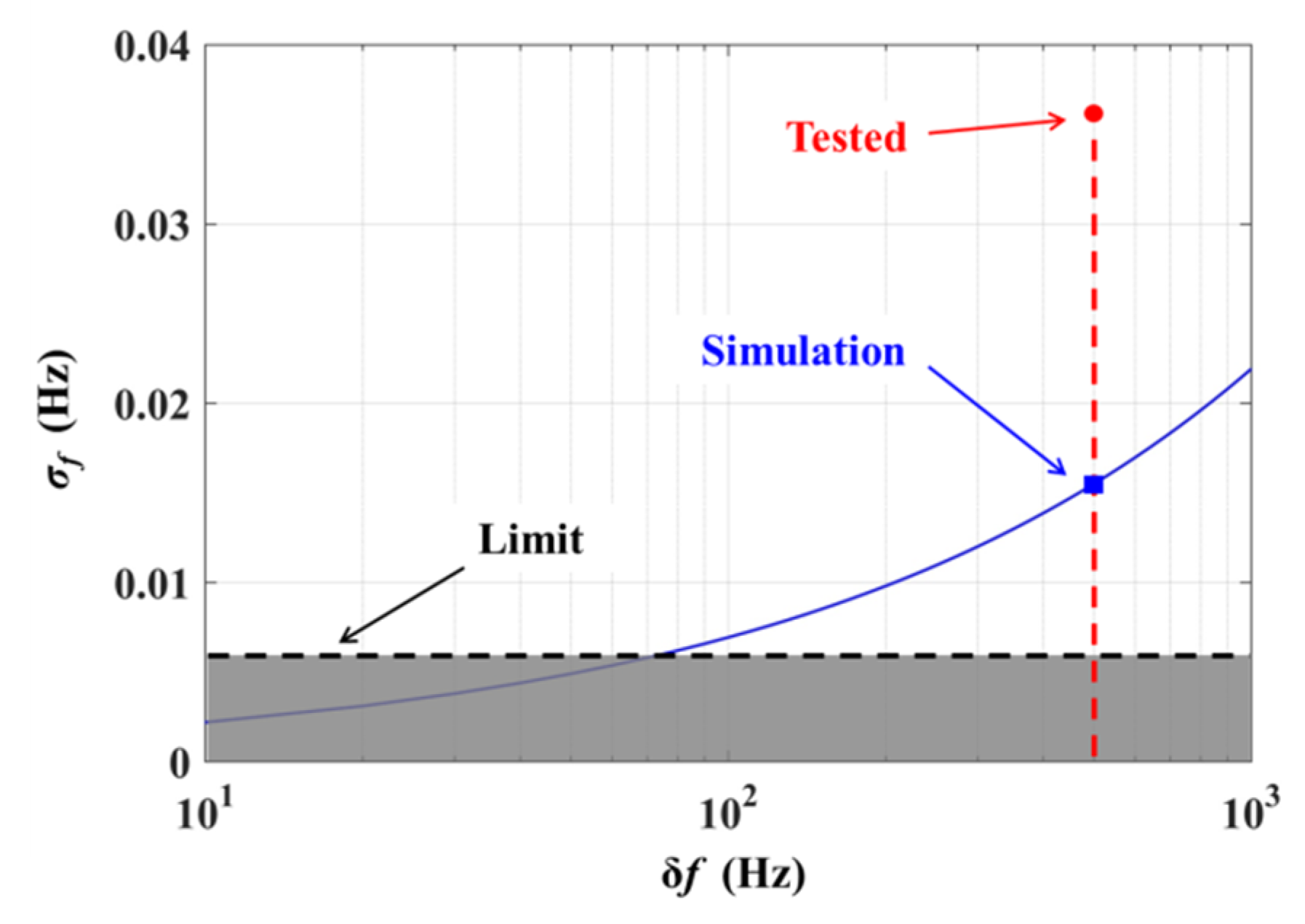
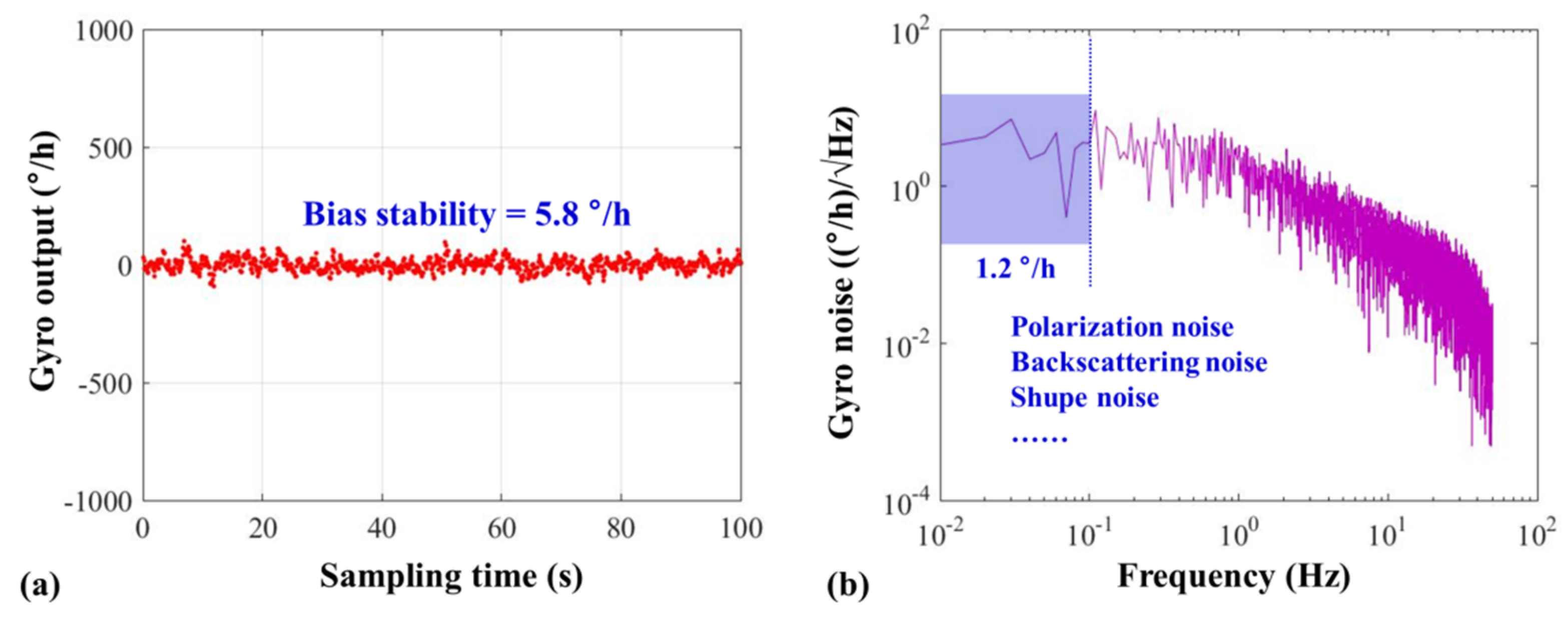
| Method | Number of LD | Noise Level | Cost (A) |
|---|---|---|---|
| OIPLL | Determined by the number of lasers N ≥ 2 | 0.032 Hz [18] | N × A |
| HHD-OPLL | 1 | 0.036 Hz | A |
© 2020 by the authors. Licensee MDPI, Basel, Switzerland. This article is an open access article distributed under the terms and conditions of the Creative Commons Attribution (CC BY) license (http://creativecommons.org/licenses/by/4.0/).
Share and Cite
Jiao, H.; Feng, L.; Zhang, Q.; Liu, J.; Wang, T.; Liu, N.; Zhang, C.; Cui, X.; Ji, X. Realization of Hollow-Core Photonic-Crystal Fiber Optic Gyro Based on Low-Noise Multi-Frequency Lasers with Intermediate-Frequency Difference. Sensors 2020, 20, 2835. https://doi.org/10.3390/s20102835
Jiao H, Feng L, Zhang Q, Liu J, Wang T, Liu N, Zhang C, Cui X, Ji X. Realization of Hollow-Core Photonic-Crystal Fiber Optic Gyro Based on Low-Noise Multi-Frequency Lasers with Intermediate-Frequency Difference. Sensors. 2020; 20(10):2835. https://doi.org/10.3390/s20102835
Chicago/Turabian StyleJiao, Hongchen, Lishuang Feng, Qingjun Zhang, Jie Liu, Tao Wang, Ning Liu, Chunqi Zhang, Xindong Cui, and Xiaoning Ji. 2020. "Realization of Hollow-Core Photonic-Crystal Fiber Optic Gyro Based on Low-Noise Multi-Frequency Lasers with Intermediate-Frequency Difference" Sensors 20, no. 10: 2835. https://doi.org/10.3390/s20102835
APA StyleJiao, H., Feng, L., Zhang, Q., Liu, J., Wang, T., Liu, N., Zhang, C., Cui, X., & Ji, X. (2020). Realization of Hollow-Core Photonic-Crystal Fiber Optic Gyro Based on Low-Noise Multi-Frequency Lasers with Intermediate-Frequency Difference. Sensors, 20(10), 2835. https://doi.org/10.3390/s20102835





